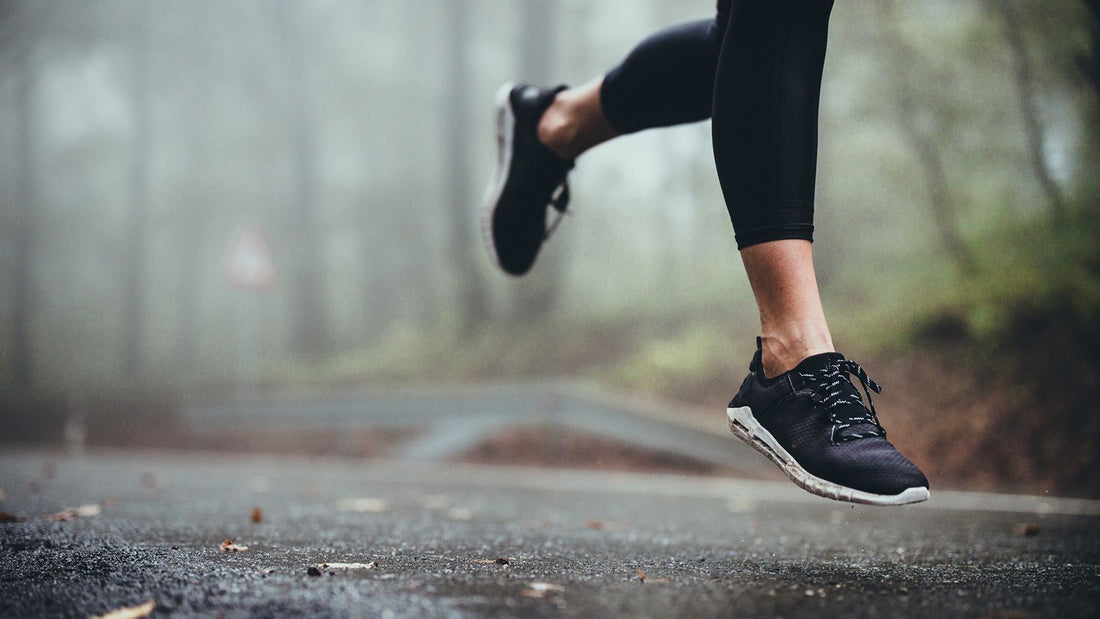Whether running around the city in a downpour or hiking in the rainforest, you must keep your feet dry and protected. However, traditional materials for waterproofing shoes are often inadequate when put up against heavy weather.
Thankfully, cutting-edge new advancements such as graphene and polyurethane membranes ensure our feet stay safe - no matter how wet the environment.
In this article, we'll be exploring what these innovative materials and technologies mean for the future of outdoor gear. Let's find out more about superior waterproofing solutions that can revolutionize your everyday adventures.
What Materials Do Traditional Waterproof Shoes Use?
Traditional waterproof shoe manufacturers use different materials to make their products reliable. The most common and least expensive option is rubber. Although not as durable or breathable, rubber is inexpensive and lightweight on foot.
Moreover, waterproof running shoes can feature synthetic fibers like nylon and polyester. That's because they can repel water and remain lightweight and flexible than harder materials like leather.
Additionally, textiles such as GORE-TEX and eVent allow for greater breathability than their predecessors while still providing superior waterproof protection from the elements. Finally, natural fabrics such as wool provide a considerable amount of insulation for the wearer.
These low-tech materials remain popular due to their lightweight construction and reliable protection against moisture ingress.
Pros and Cons of Existing Materials Used in Waterproofing Shoes
Unfortunately, each water-resistant material has its shortcomings. For instance, rubber soles can easily become worn down and leaky in wet conditions. Although dependable against water ingress, synthetic fabrics are also notoriously poor at ventilating excess heat away from the foot to prevent excessive perspiration.
Moreover, durable coatings such as polyurethane membranes provide improved protection from water but may prove less effective over long periods.
Additionally, natural materials such as wool lose their effectiveness when saturated with excessive moisture or experience too much heavy wear and tear over time. This can cause the fabric to rip or become soggy due to trapped moisture between the fibers of yarns or threads in knitted fabrics.
New Materials and Technologies Leading to Future Improvement in Waterproofing Shoes
Since conventional waterproof shoe materials struggle to provide optimal performance, brands like Loom are adopting more advanced technologies to manufacture the best waterproof running shoes.
Let's take a look at some of the most promising new materials and technologies leading to future improvements in shielding your feet from wet weather.
Graphene
Graphene is a new material that has been explored as an interesting alternative in the waterproofing of shoes due to its unique properties. It’s a single layer of carbon atoms arranged in hexagons, revealing an extraordinary combination of strength, flexibility, and lightness.
Additionally, graphene has high permeability, which efficiently conducts air throughout the material allowing for superior breathability than other conventional materials used for waterproofing.
Moreover, the nanoscale architecture of this material makes it superhydrophobic. This way, the water drops will stay relatively on top before running off rather than being absorbed into the fabric. This renders long-lasting protection from water ingress or moisture damage over time.
Microscopic Nanobeads and Nanotextiles
Microscopic nanobeads and nanotextiles are great for developing new methods for waterproofing shoes. These minuscule beads can repel water and enhance breathability due to their unique spherical shape. This creates a layer of air between the exterior surface and the internal lining.
This way, it ensures that water remains on top instead of seeping through into fabrics, where it can damage materials or cause discomfort for the wearer over time. Additionally, these nanoparticles are lightweight, making them ideal for shoe-making applications while providing effective protection against water ingress over long durations with minimal added bulk.
Smart Nanoparticle-Coated Surfaces
Smart nanoparticle-coated surfaces are one of the most exciting new developments in waterproof technology. These surfaces are created using nanotechnology to coat them with a protective molecular layer that forms an invisible barrier. It also helps keep fluids from penetrating through.
Nanoparticles behave like tiny microscopes by having multiple contact points with the surface upon which they are applied. This allows them to form a stronger water-resistant bond with each droplet of moisture that comes into contact with it.
Additionally, this coating is extremely durable and can withstand harsh temperature changes or the heavy wear and tear associated with regular use over time. Smart surfaces also offer superior protection from excessive sweat and resistance to spills and stains due to their largely nonabsorbent character.
Polyurethane Membranes
Another popular material used in the waterproofing of shoes is polyurethane membranes. This technology takes advantage of polyurethane's flexible yet strong nature to build an impenetrable barrier that prevents water from entering.
Moreover, polyurethanes are generally less susceptible to wear and tear due to their greater stretching capacity. This makes them ideal for active or outdoor activities where a comprehensive level of protection from the elements is necessary.
Additionally, once applied on the inner lining or upper part of a shoe, this membrane provides a high degree of breathability. That's because it allows air circulation in and out of the shoe for improved airflow throughout your feet and provides enhanced cooling when necessary.
These membranes also offer superior endurance and repel water without sacrificing comfort over prolonged periods - making your waterproof shoes better than ever.
Hydrophobic Synthetic Leathers
The latest advancements in water-resistant materials have led to the development of hydrophobic synthetic leathers. By benefiting from a new technology known as impregnation, these synthetic leathers repel water and allow air and moisture permeability through their porous surface structure.
Additionally, hydrophobic particles or molecules are bonded to make the fabric resistant to liquid and solids. This keeps feet cool and comfortable in wet conditions while allowing airflow within the shoe.
Moreover, these materials come in many textures and colors. This means that they can give your shoes an enhanced style while still providing superior protection against moisture damage over time. With this material improvement, waterproof shoes can remain breathable yet durable even when facing harsh weather or outdoor conditions.
Advancements in Adhesives to Completely Seam Seal Shoes
Manufacturers also use advanced adhesives with newer materials to seal shoe seams. This improves their products' waterproofing capability. Using high-strength adhesive tape or TPU-based hot melt systems, they create watertight bonds between two pieces of fabric that stand up against the elements.
Moreover, these new solutions guarantee better protection from moisture by eliminating seams or stitched gaps that would otherwise allow water passage into a shoe. Thus, it saves you from having to suffer from wet and cold feet.
This technology is also used by leading brands such as Loom, Nike, Adidas, and luxury labels to maintain an elegant look with superior waterproofness. With this refinement in sealing methods already underway, it won't be long until our shoes become truly impenetrable against any weather adversity.
Top 3 Waterproof Shoes Made with the Latest Materials and Technology
Conventional waterproof shoes can not effectively protect your feet. However, to buy the best waterproof running shoes, you can consider these reliable options:
1. Loom

The Loom waterproof shoes are designed to be an essential piece of gear for any outdoor enthusiast. Crafted with a premium, lightweight waterproof membrane construction that features welded seams, these shoes provide superior protection from the elements while remaining breathable.
The lugged outsole design provides excellent traction in wet or slippery conditions, making it perfect for navigating any terrain. The deep lugs provide added flexibility for navigating rougher trails and do not sacrifice grip on smooth surfaces.
Moreover, the shock-absorbing cushioning system is ideal for long walks or hikes on various terrains and ensures lasting comfort. With superior performance qualities, the Loom shoes make it stylish and practical to brave whatever nature throws your way!
2. Adidas Ultraboost All-Terrain

The Adidas Ultraboost All-Terrain shoes are designed to keep your feet dry in any weather. The water-resistant Primeknit upper and multi-surface traction outsole grips provide stability and incredible responsiveness while lightweight.
Optimized for long runs, the reinforced toe guard provides extra protection without sacrificing performance. With the breathable mesh lining, you can stay comfortable in any weather, whether raining or shining.
The All-Terrain shoes are also perfect for various activities, such as running on trails and jogging in unpredictable weather conditions like snowstorms or heavy rainfall. This makes this shoe among the most versatile footwear available today.
3. Hoka One One Torrent Trail Shoe

The Hoka One One Torrent 2 Trail shoe is designed to help you conquer all terrain. This shoe features an eVent® material that is waterproof, meaning your feet stay dry even in wet and muddy conditions.
The EVA midsole provides improved stability and shock absorption, which helps protect your joints from wear and tear on rough terrain. Its low-profile lugs provide a multi-directional grip on some of the toughest trails. Additionally, these shoes are perfect for trail running or any outdoor activity you can find yourself doing in nature.
Moreover, its tongue offers additional protection against mud and other debris while allowing enough breathability. Thus, your feet can stay comfortable all day long.
Final Thoughts
Waterproof shoes need not be restrictive and uncomfortable - thanks to the latest advancements in materials, technologies, and engineering.
Whether looking for a reliable running shoe or one for outdoor adventures, you can use many advanced waterproofing shoes to keep your feet dry.
From graphene-coated surfaces to polyurethane membranes and hydrophobic leathers, many materials and technologies work together to protect our feet against the elements. These advancements will continue revolutionizing our daily lives for better experiences each time we step into an adventure.

